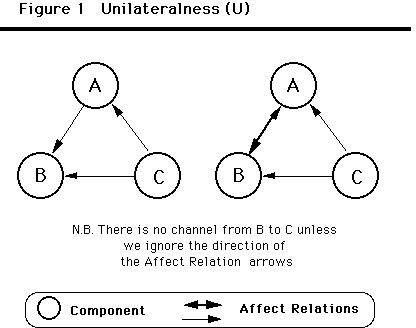 Educational Systems Theory
Educational Systems Theory
Property: Unilateralness (U)
Definition:
- 40) "Educational system unilateralness is not either complete connnectedness or strongness and every two components have a channel between them with respect to affect relations."
Comments:
- In a unilateral affect relation either component x can affect y, or y can affect x, but not both. Therefore, a unilateral digraph is one that, although every possible pair is connected by at least a one way channel (i.e. there are no disconnected comp
onents); but that has at least one pair of components which lacks the possibility of bi-directional affect connection, even indirectly. That is, although all components are connected, a pair (or pairs) lacks any possibility of even indirect bi-directiona
l connection. This condition also implies that the digraph is neither strongly nor completely connected.
Illustration:
- In this figure notice that there is no channel from B to C, although there are no disconnected components, nor is the digraph strong, nor is it completely connected.

Examples:
- The structure of any "top-down" command and control oriented bureaucratic organization, whether military, industrial, political, or even educational, will exhibit a high degree of unilateralness . Orders are presumed to flow from the top of the organi
zation (i.e. the supreme commander or superintendent of schools) through many one-way relations, until they at arrive at the bottom level, where the work is actually done (e.g. foot soldiers or teachers).
While there may well be justification for clear lines of authority in a military context, the downward focused command structure tends to inhibit information from flowing back upward in the organization. This problem can be especially acute in environmen
ts like aircraft cockpits, where the captain may well not properly attend to information from "lower ranking" crew, sometimes with fatal results.
- It is instructive that business has recognized the difficulties inherent in unilaterally structured, function-oriented, hierarchies and are moving in the direction on "flatter" organization structures and toward cross-functional teams. It is less clea
r that K-12 is ready to move, en mass, in this direction. However, one of the premises of school restructuring is to move toward stronger formal structures
Related Terms:
- Component (def.)
- Affect Relation (def.)
- Feedin (H #91)
- Weakness (H #115)
- Disconnectedness (H #115)
- Input (H #115)
- Fromput (H #115)
Hypotheses Containing the Property: Unilateralness
- #91
- #115
Terms Similar to Unilateralness:
- Complete Connectedness
- Strongness
- Weakness
- Disconnectedness
Go to the top of this document.
 Go to SIGGS Home Page.
Go to SIGGS Home Page.
Last updated by John Beckerman,
4/4/95.
 Educational Systems Theory
Educational Systems Theory Educational Systems Theory
Educational Systems Theory
 Go to SIGGS Home Page.
Go to SIGGS Home Page.